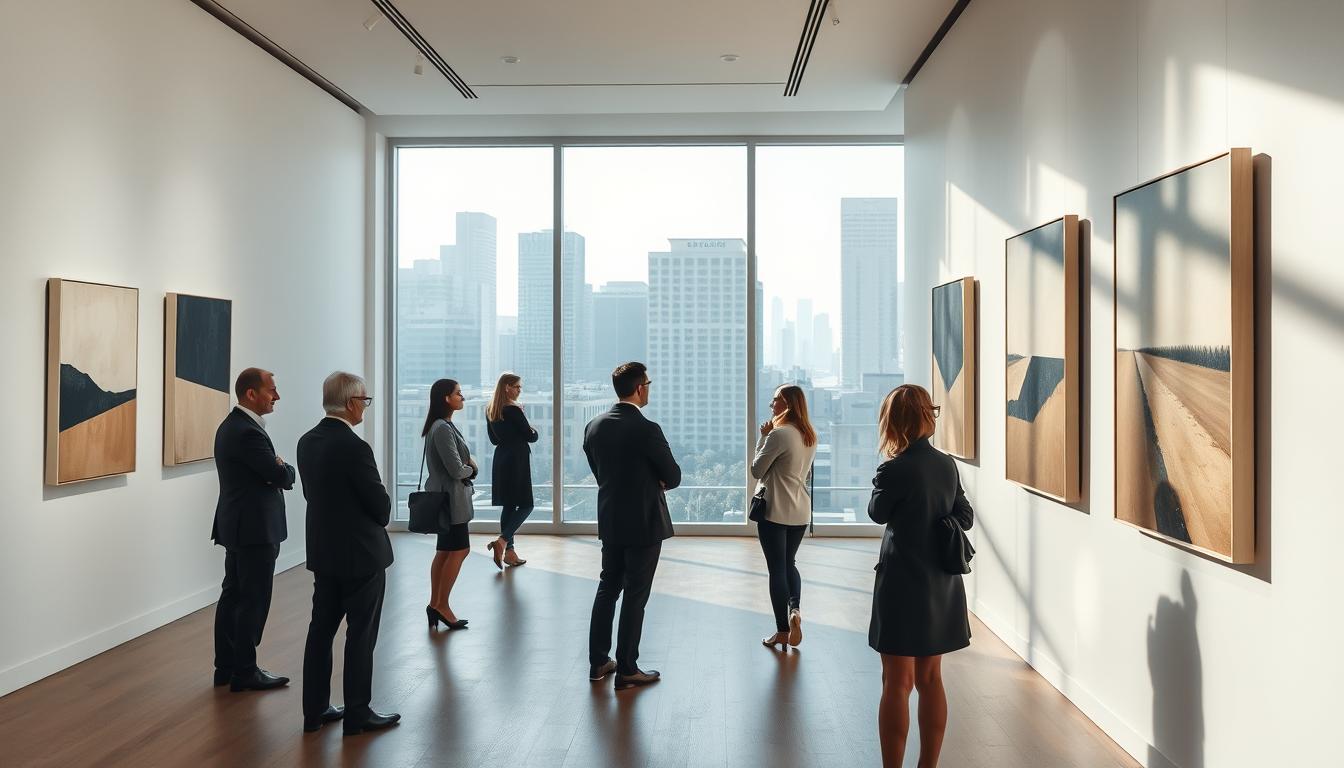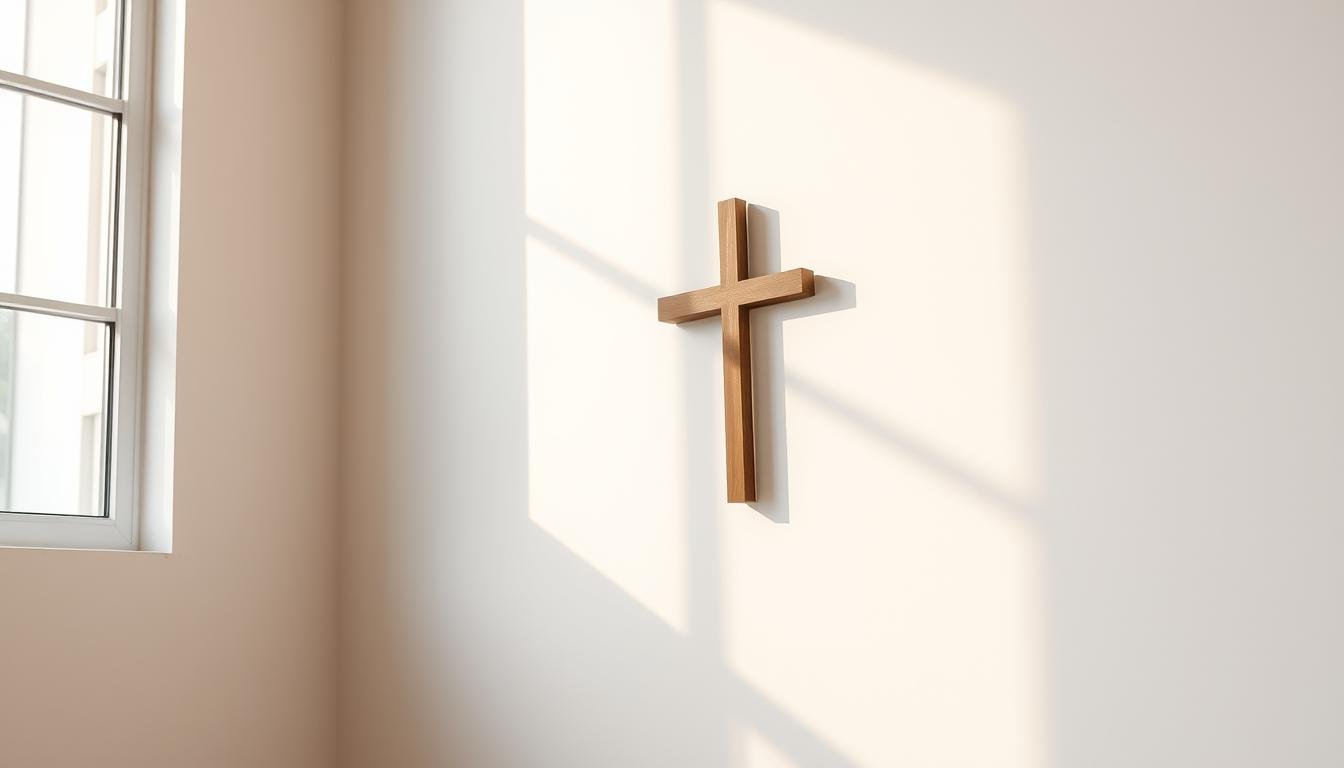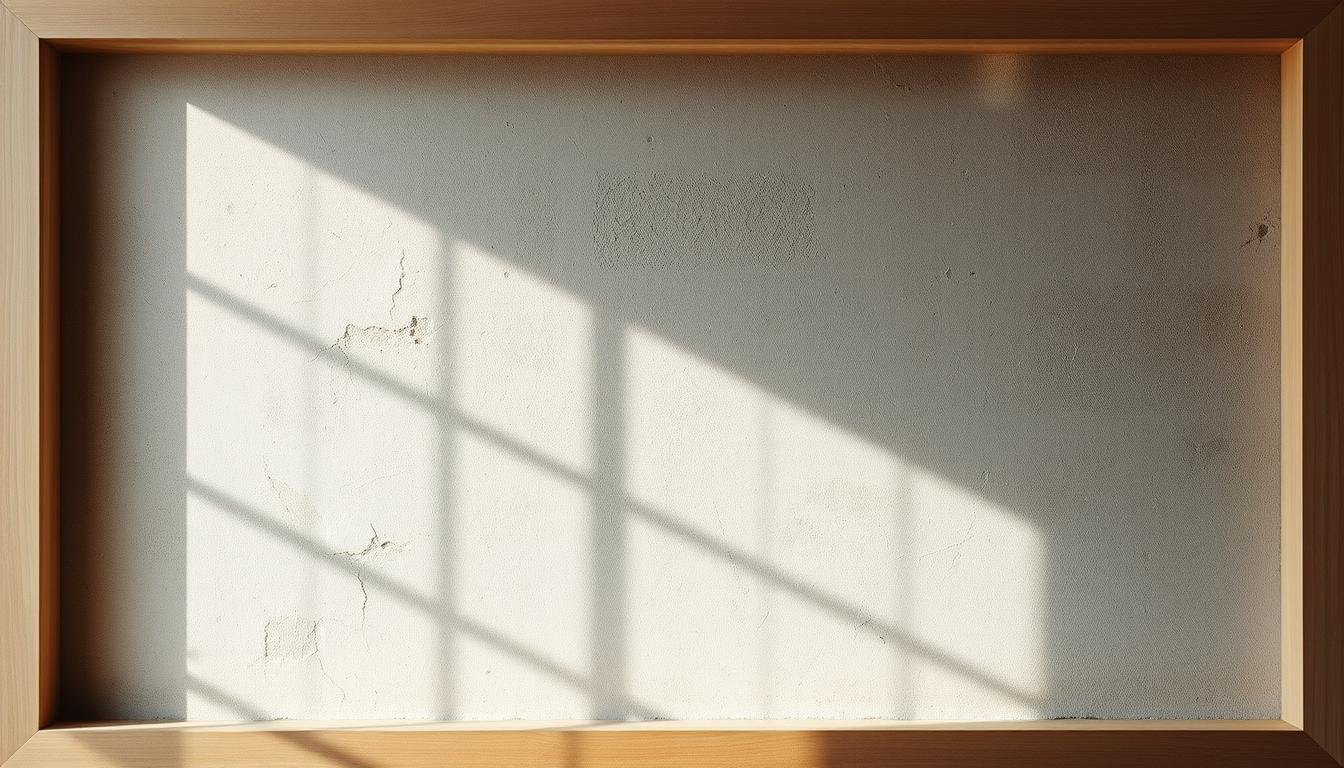Can a single shape or a strip of light change how we feel about a room—or even the world? This question drives a new wave of makers who trace ideas back to the 1950s and 60s, when Minimal Art stripped works to geometric order and clean lines.
Today’s scene links those pioneers to a fresh generation that distills complexity into clear form. Expect a listicle that highlights founding figures and current voices, and that bridges historic ideals with present practice.
The focus is on pared-down elements: repetition, precise execution, and industrial materials across painting, sculpture, and light installations. We’ll touch on Donald Judd’s “quality whole,” Dan Flavin’s fluorescent spaces, and Sol LeWitt’s conceptual grids, and show how contemporary names adapt that vocabulary for new contexts.

What follows: clear definitions, core traits, pioneers, contemporary creators, media, philosophy, and how these works fit in interiors and collections.
Key Takeaways
- Minimalism began in the U.S. mid-20th century and still shapes today’s art movement.
- Look for geometric order, repetition, and precise, industrial materials.
- Classic pioneers provide the framework for new practitioners worldwide.
- Contemporary creators adapt minimal vocabularies to modern contexts.
- The approach suits collectors, designers, and mindful viewers alike.
What Minimal Art Is and Why It Still Matters Today
Minimal Art began as a clear counterpoint to Abstract Expressionism. In the united states during the 1950s and 1960s, makers rejected gesture and narrative. They embraced strict geometry, repetition, and industrial processes.
By the 1960s the new york scene codified a set of practices: seriality, non-relational composition, and fabrication that treated works as objects rather than pictures. Studios and galleries became testing grounds for this pared-down approach.
From Abstract Expressionism to radical simplicity in the 1960s United States
Minimal Art cut away symbolism so perception became the main event. What you see is the full experience. That directness still resonates in museums and contemporary studios as a buffer against visual overload.
Key difference between Minimal Art and broader Minimalism
Minimal Art is a specific art movement rooted in visual practice. Broader minimalism spans music, literature, design, and lifestyle. Both prize simplicity, but only the former refers directly to artworks, objecthood, and the transformation of painting into sculpture, stacks, and light works.
- Why it matters: it redefined the artist’s role toward planning, fabrication, and material logic.
- Durability: the language of reduction keeps it vital in collections and contemporary practice.
Core Characteristics: Shapes, Materials, and Space
Minimal Art depends on a tight visual vocabulary of ordered shapes and measured repetition. This economy of means makes every edge, surface, and interval count.
Geometric forms, seriality, and non‑relational composition
Geometric shapes and simple modules map the viewer’s attention across a work. Repetition often appears in a series, inviting close comparison of slight shifts.
Non‑relational composition keeps elements equal in weight. Pieces do not dramatize interaction; they hold steady in balance and proportion.
Industrial processes and materials that reshape painting and sculpture
Artists favored industrial materials—steel, aluminum, Plexiglas, and fluorescent fixtures—to achieve crisp edges and uniform finishes. These materials strengthen the sense of the work as an object.
Painting moved toward objecthood with thick supports and flat bands. Sculpture adopted modular logic—stacks, plates, and repeated cubes—to redefine how bodies move around planes and edges.
- Clarity: limited forms focus perception on surface, light, and scale.
- System: serial arrangements test variation and rhythm across almost identical units.
- Presence: the object’s proportion and finish create the primary experience, not narrative.
Pioneers of Minimal Art: The Foundational Artists
A small group of mid‑20th century makers reimagined what an art object could be, shifting attention from brushwork to physical presence.
Donald Judd: Objects, stacks, and the “quality whole”
Donald Judd left painting in 1963 to make freestanding objects and stacks. He used aluminum and Plexiglas and insisted each unit work as part of a “quality whole.”
Dan Flavin: Fluorescent light, space, and color atmospheres
Dan Flavin adopted commercially available fluorescent light tubes to reshape rooms. His fluorescent light installations bathed interiors in hue and altered how viewers move through space.
Sol LeWitt: Structures, wall drawings, and conceptual planning
Sol LeWitt treated the idea and the plan as the artwork. His structures and wall drawings allowed variations across sites while keeping the core concept intact.
Carl Andre and Robert Morris: Floor plates, mirrored cubes, and viewer experience
Carl Andre placed metal plates and bricks on floors to make walking part of looking. Robert Morris used mirrored cubes to fold spectators and surroundings into the piece.
Painting lineage and material experiments
Agnes Martin’s quiet grids, Frank Stella’s mantra of what you see, and Ellsworth Kelly’s color panels pushed painting toward objecthood.
Eva Hesse’s fragile seriality, Judy Chicago’s chromatic installations, Tony Smith’s modular forms, and Anne Truitt’s painted columns expanded scale and material logic.
| Artist | Primary Move | Key Material | Impact on Space |
|---|---|---|---|
| Donald Judd | From painting to stacks | Aluminum, Plexiglas | Object as whole |
| Dan Flavin | Light as medium | Fluorescent tubes | Architectural color |
| Sol LeWitt | Conceptual plans | Wall drawings, modular structures | Instruction-based variations |
| Carl Andre / Robert Morris | Floor and mirror works | Metal plates, mirrored surfaces | Viewer inclusion |
New York served as a crucible for these shifts. Despite varied methods, these pioneers shared clarity of form, economy of means, and strict material choices.
Modern Minimalist Artists Shaping the Present
Contemporary practitioners translate restraint into distinct visual languages that reward slow looking. Each maker here updates mid‑century clarity with new materials and quiet processes.

Maria Yelletisch
Repetition defines her practice. Small brushstrokes build serene fields that resolve into a single, cohesive work from a distance.
Carsten Beck
Beck moved from graphic design to oil and lithography. His rectangles and triangles borrow from architecture and Concrete Art.
Sung Yeon‑Hwa
Sung balances empty space with fine lines on Hanji and canvas. The measured composition invites slow, contemplative viewing.
Cindy Leong
Leong draws on Dansaekhwa and mindfulness. Her surfaces emphasize material process and equanimity over gesture.
Armando Chant
Chant converts stereoscopic negatives into embroidered monochromes. Pigment glazes create layered, memory‑filled color fields.
Alexander Jowett
Jowett centers horizontal lines as tools for inward reflection. He works in linen, rope, and denim to open meditative space.
| Artist | Core Method | Key Material |
|---|---|---|
| Maria Yelletisch | Repeated brushmarks forming cohesive fields | Oil on canvas |
| Carsten Beck | Architectural geometry, lithography | Oil, lithograph |
| Sung Yeon‑Hwa | Restrained lines and breathing space | Hanji mixed media |
| Cindy Leong | Process-led, Dansaekhwa influence | Painted surfaces |
| Armando Chant | Embroidered negatives with pigment washes | Linen, thread, pigment |
| Alexander Jowett | Horizontal bands and tactile materials | Linen, rope, denim |
Why follow them: each artist retools color, surface, and structure to renew the essence of reduction. Watch these works as evolving series that reshape how we see calm in contemporary practice.
How Minimalism Evolved: From the 20th Century to Now
Minimalism began as a concentrated reaction in mid‑century studios and galleries. Over time, it moved from a U.S.‑centered practice into a global language used across many contexts.
1960s New York served as the movement's launchpad. Makers in the united states refined seriality, objecthood, and strict material choices that defined the 20th century turn in art.
In the decades that followed, artists in Europe, Asia, and Oceania adapted those ideas to local craft, architecture, and spiritual traditions. Residencies, fairs, and online platforms helped the language travel fast.
The core tenets—clarity, repetition, and reduced means—remain. But new materials and fabrication techniques expanded scale, color, and perception. Today minimalism can be meditative, architectural, or phenomenological without losing rigor.
Why it matters now: time has diversified the movement. Intergenerational dialogues keep pioneers’ principles alive while enabling fresh experiments that answer our overloaded sensory world.
| Era | Key Shift | Geographic Spread |
|---|---|---|
| 1960s | Seriality, objecthood | New York, united states |
| Late 20th century | Material and conceptual expansion | Europe, Japan, Australia |
| 21st century | Digital circulation and cross‑discipline practice | Global |
Painting, Sculpture, Light: Media That Define the Movement
Painters, sculptors, and light practitioners each rewrote how material and site shape perception. This section looks at how canvas and panels became objects, how modular pieces claim floor and wall, and how fluorescent and ambient systems change rooms.
Painting as object: canvas, bands, and two‑dimensionality
Painters flattened gesture into calibrated bands and broad monochromes. Strips and clear edges make the painting read as an object with its own plane and frame.
Multiple canvas panels can act like modules in a series, aligning painting with the logic of serial sculpture. Small changes in color or proportion alter perceived depth and distance.
Sculpture and installation: cubes, stacks, and site-specific works
Sculpture moved toward modular clarity: cubes, stacks, and floor plates organize movement and sightlines. These forms treat the gallery as part of the piece, activating how viewers circulate.
Walls and floors become active sites. Sol LeWitt’s wall drawings and Robert Morris’s mirrored cubes show how placement and finish change perception of the same object.
Light and perception: fluorescent and ambient interventions
Light practices use fluorescent fixtures and soft glow to turn rooms into chromatic fields. Dan Flavin’s tubes reshape architecture by bathing surfaces in steady hue.
When light meets bands, canvas, or stacks, it alters edges and scale. The dialogue between painting and sculpture often hinges on this subtle atmospheric shift.
| Media | Typical Forms | Site Effect |
|---|---|---|
| Painting | Bands, panels, monochrome | Frame as object; altered wall presence |
| Sculpture | Cubes, stacks, floor plates | Directs circulation; invites touchless interaction |
| Light | Fluorescent tubes, ambient fields | Transforms color and spatial atmosphere |
For a deeper look at how bands and canvas redefine painting, see this minimalist painting overview.
Philosophy and Influence: Zen, Tao, and “What You See Is What You See”
Some of the movement’s deepest roots come from Zen and Taoist thought, paired with a strict attention to what the eye registers.
Agnes Martin drew on Taoism and Zen to shape inward grids and muted palettes. Her small, measured lines create calm fields that invite quiet attention. The work asks viewers to rest in perception rather than seek a story.
Frank Stella gave the era a terse, clarifying motto. In his words,
“What you see is what you see.”
That phrase centers the act of looking. It ties painting directly to surface and structure, cutting away interpretation.
Philosophies here range from spiritual practice to phenomenology. Both push for disciplined restraint and focused seeing. Even muted color functions as a tool for contemplation, not emotive display.
By contrast, abstract expressionism relied on overt gesture and inner drama. Minimalism turned from expression toward order and perception. These threads still shape how many makers work today, from ritualized studio routines to meditative mark‑making.
Geographies of Minimalism: From New York to a Global Field
A focused moment in the united states soon opened into a global exchange of form and idea. What began in the 20th century in new york became a set of practices that museums and schools carried abroad.
United States origins and the New York nexus
New york galleries, critics, and makers in the 1960s created a tight debate about seriality, objecthood, and material logic. That nexus gave the movement a public profile and a set of rules that others could test and revise.
Contemporary voices from Europe, Asia, and Oceania
Today, Europe, Asia, and Oceania take those rules and make them local. Carsten Beck, Sung Yeon‑Hwa, and Cindy Leong show how scale, craft, and climate change how reduction reads in different spaces.
Travel, residencies, and online platforms keep the dialogue alive. Shared references now circulate across the world, letting new generations link clarity to sustainability, craft revival, and embodied viewing.
Look locally: regional shows and collections reveal how the same minimalist language adapts to building types, public and private space, and cultural expectations. For background on the movement’s roots and spread, see this minimalism overview.

How Minimalist Works Live in Interiors
Well-chosen artworks can set the tone of a room and organize how we move through it. Their clean lines and restrained palettes help a space feel calm and ordered.
Clean lines, geometric shapes, and calm spatial balance
Geometric shapes and measured proportions make rooms breathe. Use singular, strong pieces to anchor living areas and avoid visual clutter.
Think in relation: height, spacing, and the distance between works shape circulation. Small changes in placement will alter sightlines and the overall aesthetic.
Selecting paintings, sculptures, and light pieces for modern spaces
Choose paintings and sculptures with clear composition and restrained color to ground furniture without competing for attention. Light-based pieces can gently reshape space, casting chromatic atmospheres that harmonize with finishes.
Favor simple materials—metal, glass, wood, fabric—that echo architectural textures. Let geometric forms and balanced proportions create calm flow across adjacent spaces.
- Balance a few strong pieces rather than many small items to protect sightlines.
- Test sightlines in natural and artificial light to see how color and edges behave over the day.
- Place works so color fields and edges can breathe; this preserves a lasting aesthetic that adapts as layouts change.
Conclusion
Restraint remains the movement’s core: clear form, measured surface, and exact proportion guide how we see art today.
The 1960s in the United States and New York set rules that still shape practice. Pioneers—Judd’s objects, Flavin’s fluorescent light, LeWitt’s structures, Morris’s mirrored pieces—gave painting and sculpture new aims.
Contemporary creators expand materials and canvas strategies while keeping that disciplined approach. See works in person to feel how color, space, and object presence together form full perception.
If you collect or curate, favor composition, lines, and balanced form. Minimalism’s power lies in what is left out: the result is focused, calm, and timed to perception.
Enhance Your Space with Unique Modern Masterpieces by Chiara Rossetti
Are you inspired by the innovative mediums and conceptual depth highlighted in our exploration of contemporary art? You’re not alone! Today’s art enthusiasts are seeking cultural relevance and emotional connections in their artwork. However, finding pieces that resonate with modern themes and fit your unique style can be a challenge. That’s where we come in!
At Rossetti Art, we specialize in canvas prints, original paintings, and modern sculptures that celebrate the spirit of now. Each piece created by Chiara Rossetti brings a personal touch that connects deeply with current social narratives—just like the modern masterpieces discussed in the article. Don’t miss out on the chance to elevate your home decor with breathtaking artwork that speaks to your values and aesthetic. Explore our collection today and find your perfect piece! Act now, and transform your space into a gallery of inspiration!
FAQ
What is minimal art and how did it emerge?
Minimal art emerged in the 1960s United States as a reaction to Abstract Expressionism. Artists reduced visual elements to geometric shapes, simple lines, and plain surfaces to focus attention on form, space, and material. Influential figures like Donald Judd, Dan Flavin, and Sol LeWitt helped define the movement by treating paintings and sculptures as objects rather than illusions.
How does minimal art differ from broader minimalism?
Minimal art is a specific art movement centered on reduction, seriality, and non‑relational composition. Broader minimalism extends to design, architecture, and lifestyle and often stresses simplicity for function and living. In art, the emphasis stays on visual presence, material honesty, and how works occupy space.
What are the core characteristics of these works?
Core traits include geometric forms, repetition, clean lines, and spare palettes. Artists use industrial materials—aluminum, concrete, fluorescent tubing, and painted panels—and methods such as serial production or precise fabrication. The result foregrounds surface, volume, and the viewer’s spatial experience.
Which materials and processes are common in minimal art?
Common choices are metal, plywood, concrete, glass, fluorescent light, and stretched canvas treated as an object. Industrial fabrication and found components reshape painting and sculpture, while techniques like modular stacking, mirrored surfaces, and wall drawings emphasize construction and perception.
Who were the pioneers of the movement?
Key pioneers include Donald Judd (stacks and the “quality whole”), Dan Flavin (fluorescent light installations), Sol LeWitt (conceptual structures and wall drawings), Carl Andre and Robert Morris (floor works and material experiments), and painters such as Agnes Martin, Frank Stella, and Ellsworth Kelly, who explored lines, bands, and color fields.
How do artists like Dan Flavin and Donald Judd differ in approach?
Dan Flavin used fluorescent light to create color atmospheres and to alter architectural space. Donald Judd focused on fabricated objects—boxes, stacks, and units—emphasizing objecthood and the relationship between works, wall, and floor. Both prioritize perception but use different media and strategies.
Are there notable women associated with this practice?
Yes. Agnes Martin brought contemplative grids and inward spirituality to her paintings. Eva Hesse introduced tactile materiality and fragility. Judy Chicago expanded scale and feminist subject matter, while Anne Truitt explored painted wooden forms and subtle color shifts.
Who are contemporary practitioners keeping this tradition alive?
Contemporary voices include artists such as Maria Yelletisch (repetition and pattern), Carsten Beck (architectural geometry), Sung Yeon‑Hwa (quiet linear compositions), Cindy Leong (meditative Dansaekhwa‑influenced works), Armando Chant (monochrome and texture), and Alexander Jowett (horizontal bands and open spaces).
How has the movement evolved since the 20th century?
Since the 1960s, the approach broadened globally and integrated diverse materials, technologies, and cultural references. While early work emphasized strict reduction, later practices blend minimal strategies with craft, color theory, and site specificity, creating new dialogues about space and perception.
What role does light play in these works?
Light functions as medium and material. Fluorescent and ambient light installations shape perception, color, and atmosphere. Artists like Dan Flavin used light to define planes and alter how viewers experience architecture, transforming walls and rooms into active parts of the work.
How do paintings and sculptures coexist within the movement?
In minimal art, paintings often become objects—canvas treated in bands or slabs—while sculpture emphasizes modular units, cubes, and site‑specific installations. Both forms share a focus on surface, edge, and how works occupy and define space rather than depict imagery.
What philosophical influences inform the aesthetic?
Many practitioners drew on Zen and Taoist ideas of simplicity, presence, and the primacy of perception. Frank Stella’s “What you see is what you see” motto and Agnes Martin’s meditative approach highlight inward focus and the viewer’s direct encounter with form.
Where did minimal art originate and how global is it now?
The movement began in New York and other U.S. centers in the 1960s, then spread internationally. Today, artists across Europe, Asia, Australia, and beyond adapt minimalist strategies to local materials and cultural contexts, making the field truly global.
How can collectors integrate these works into interiors?
Choose pieces that relate to a space’s scale and light. Clean lines, geometric shapes, and restrained color palettes create calm balance. Sculptural works can anchor a room; paintings or light pieces can define a wall. Consider sightlines and materials for a cohesive, meditative environment.
Are minimalist works suitable for public spaces?
Yes. Modular units, stacks, and site‑specific installations often translate well to public settings. Durable industrial materials and clear geometric forms withstand scale and interaction, while light works can alter atmosphere and circulation in large interiors.
How do I learn more or see important works in person?
Visit major museums like the Museum of Modern Art, Dia:Beacon, Tate Modern, or the Hirshhorn, which hold seminal pieces by Judd, Flavin, LeWitt, and others. Biennials, contemporary galleries, and dedicated foundations also showcase contemporary practitioners and new commissions.







Leave a comment
This site is protected by hCaptcha and the hCaptcha Privacy Policy and Terms of Service apply.